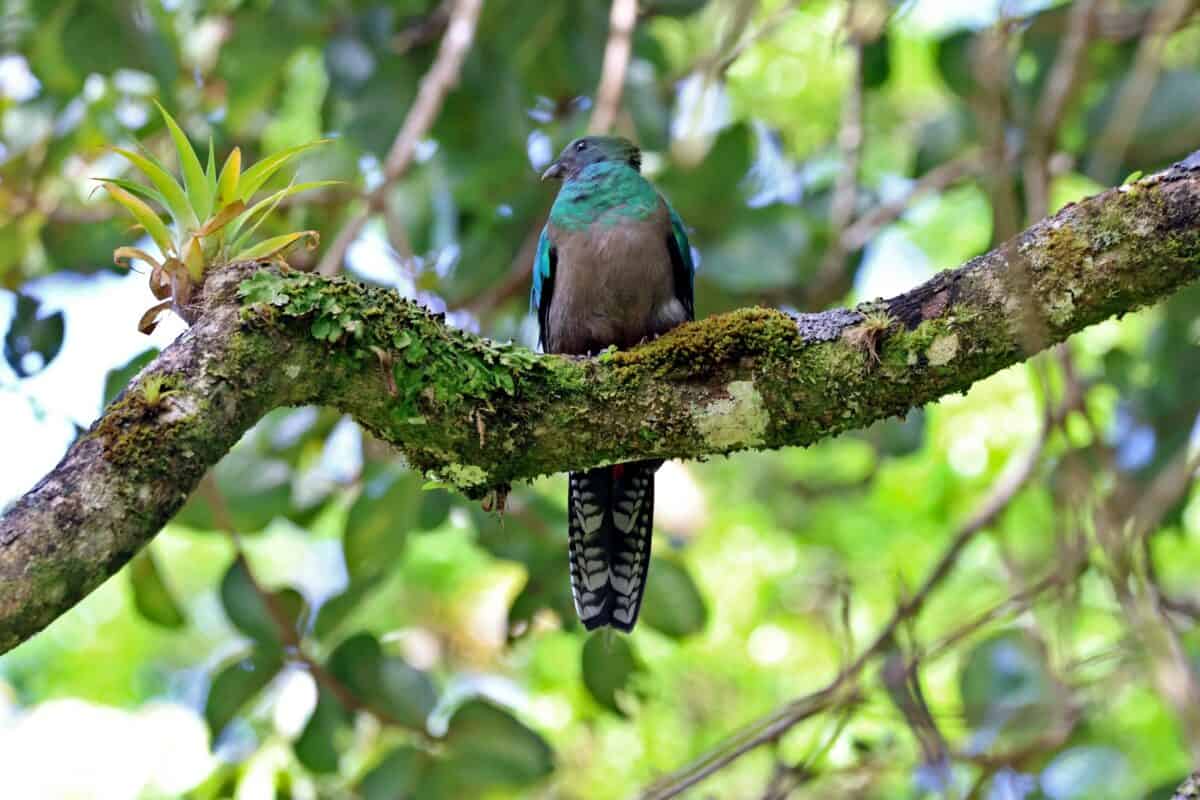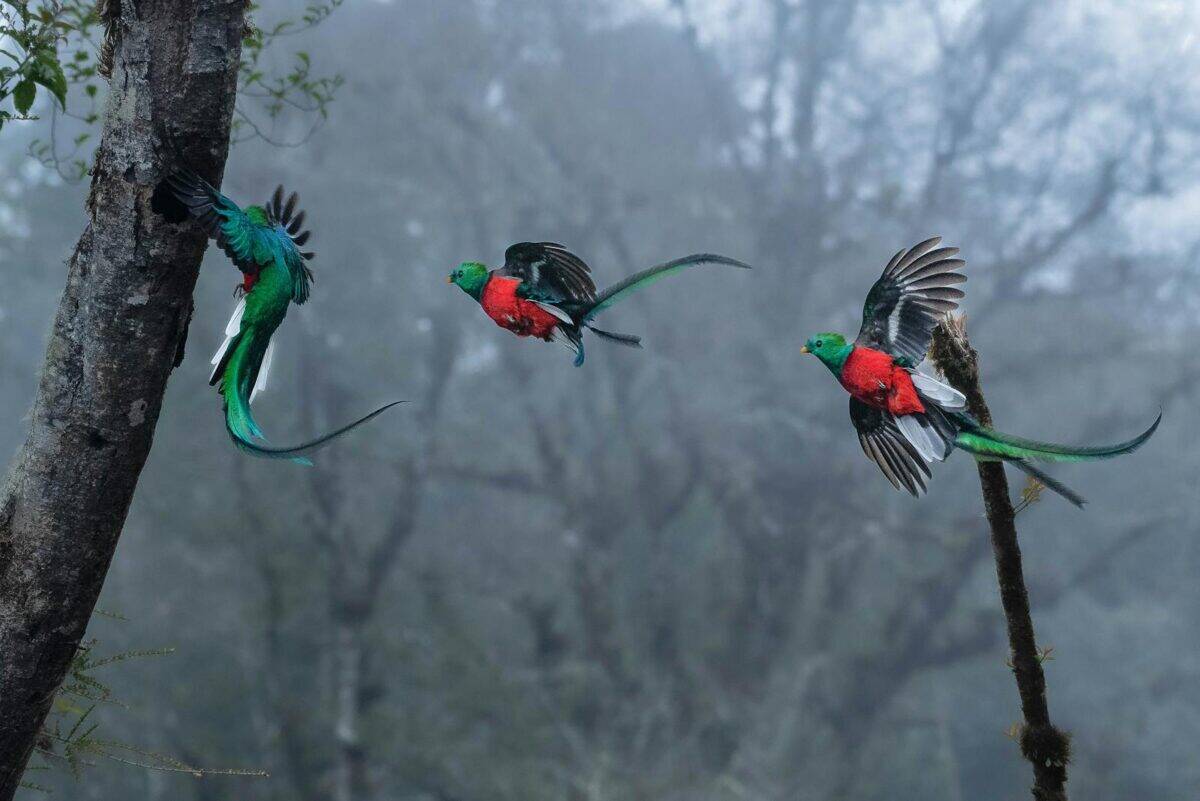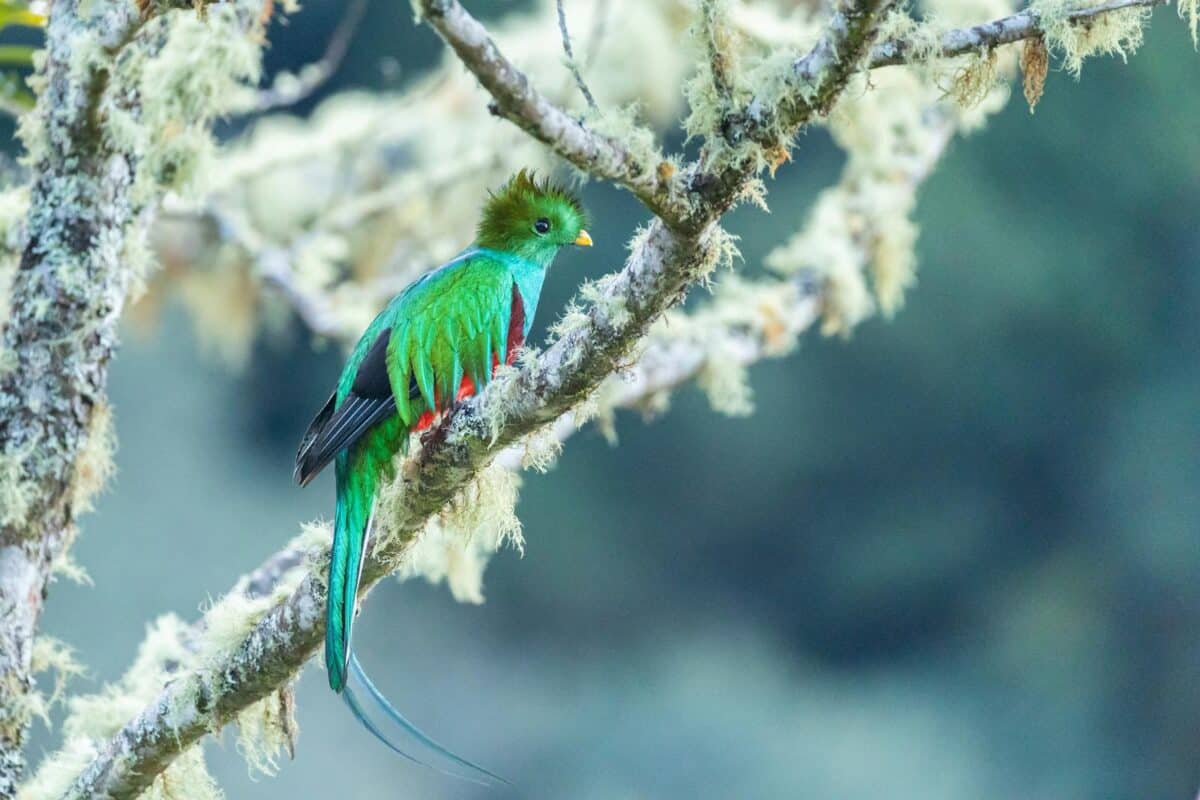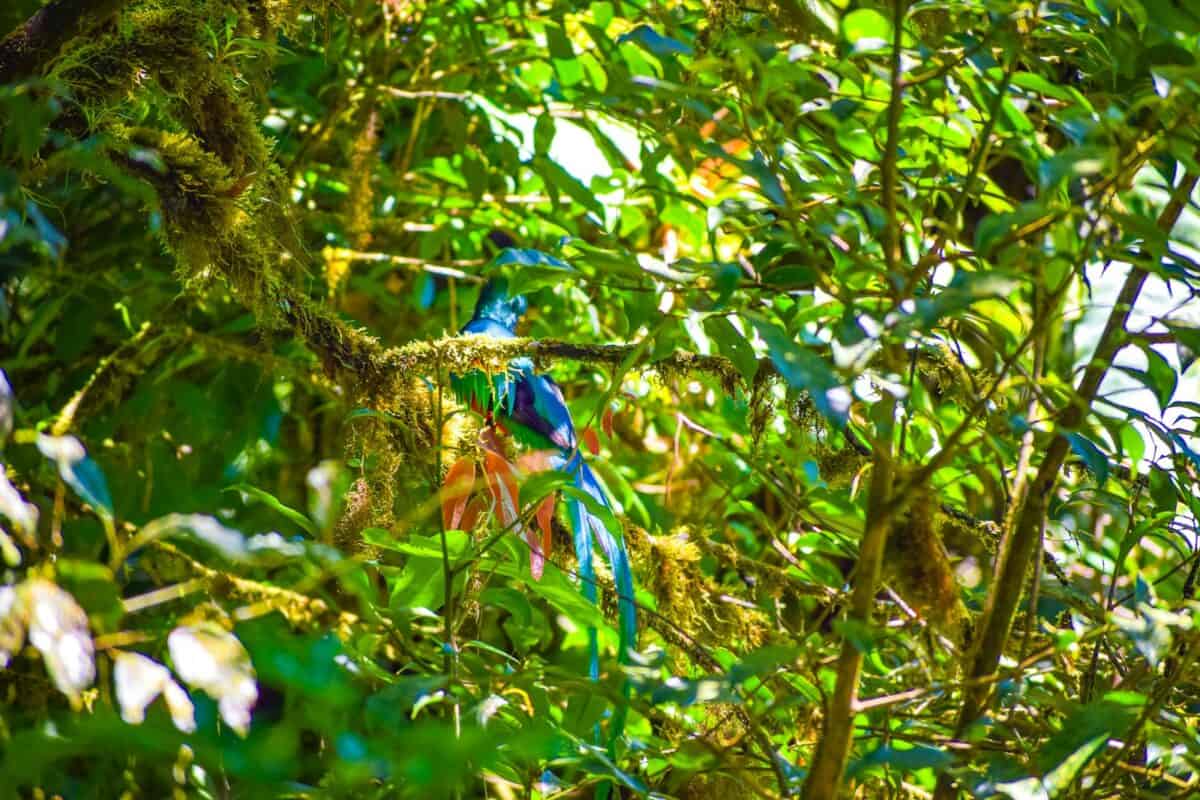Deep in the misty cloud forests of Central America lives a bird so magnificent that ancient civilizations considered it divine. The Resplendent Quetzal (Pharomachrus mocinno) stands as one of nature’s most dazzling masterpieces, with iridescent plumage that shifts between emerald, gold, and azure depending on how light strikes its feathers. More than just a pretty face in the avian world, this remarkable creature has played a central role in Mesoamerican culture for thousands of years and continues to captivate both ornithologists and casual bird enthusiasts alike. Today, as its cloud forest home faces increasing threats, understanding and appreciating the resplendent quetzal has never been more important. This article explores the fascinating world of this legendary bird—from its unique physical characteristics and behaviors to its cultural significance and conservation status.
A Living Jewel of the Cloud Forest

The Resplendent Quetzal is aptly named for its extraordinary beauty. Males display a vibrant metallic green plumage across their head, back, and chest that can appear blue or gold when caught in different angles of light. This iridescence isn’t produced by pigments but by the microscopic structure of the feathers that scatter light in specific ways. Their most striking feature is undoubtedly the elongated upper tail coverts that extend far beyond the actual tail, creating flowing “train” feathers that can reach up to 3 feet (1 meter) in length. These exquisite plumes have a brilliant emerald-green color that contrasts dramatically with the male’s crimson breast and belly. Females, while less flamboyant, possess their own subtle beauty with a bronze-green head, back, and chest, and a striking red belly, though they lack the extended tail coverts of the males.
Taxonomic Classification and Relatives

The Resplendent Quetzal belongs to the Trogonidae family, an ancient group of birds that evolved around 65 million years ago. Within this family, it’s classified in the genus Pharomachrus, which includes five species of quetzals. The Resplendent Quetzal itself comprises two recognized subspecies: P. mocinno mocinno (the Northern Resplendent Quetzal) found from southern Mexico to Nicaragua, and P. mocinno costaricensis (the Southern Resplendent Quetzal) found in Costa Rica and western Panama. The quetzal’s closest relatives include other trogons – colorful, forest-dwelling birds distributed throughout tropical regions worldwide. Despite their similar appearances, genetic studies show that New World trogons (like the quetzal) diverged from their Old World counterparts over 30 million years ago, making them an excellent example of convergent evolution.
Geographic Distribution and Habitat

The Resplendent Quetzal inhabits a relatively narrow geographic range spanning the mountainous regions from southern Mexico through Guatemala, El Salvador, Honduras, Nicaragua, Costa Rica, and into western Panama. These birds are specifically adapted to the cloud forest ecosystem – a unique type of high-altitude rainforest characterized by persistent cloud cover, high humidity, and cooler temperatures than the lowland tropics. Quetzals typically live at elevations between 4,000 and 10,000 feet (1,200-3,000 meters), where they depend on the specific combination of dense forest, high moisture, and abundant food resources. Their preferred habitat features mature trees draped with epiphytes, mosses, and lichens, creating the perfect environment for both nesting and foraging. Unfortunately, this specialized habitat preference makes quetzals particularly vulnerable to deforestation and climate change, as cloud forests represent one of the most threatened ecosystems in the tropics.
The Remarkable Diet of the Quetzal

The Resplendent Quetzal’s diet revolves primarily around fruit, with a particular fondness for wild avocados from the Lauraceae family. Their relationship with these fruits represents a fascinating ecological partnership: quetzals consume the fruit whole, digest the pulp, and then regurgitate or excrete the seeds intact, effectively dispersing them throughout the forest. This makes quetzals vital seed dispersers that help maintain forest diversity and regeneration. While fruit constitutes about 80% of their diet, quetzals are not strict frugivores. They supplement their diet with protein by hunting small prey, including insects, lizards, frogs, and snails, which they capture during swift, acrobatic flights through the forest canopy. Their specialized digestive system handles this mixed diet efficiently, with a relatively short intestinal tract ideal for processing easily digestible fruits but still capable of extracting nutrients from animal prey.
Breeding Behavior and Reproduction

The breeding season of the Resplendent Quetzal coincides with the period when their favorite fruits are most abundant, typically occurring between March and June. During courtship, males perform spectacular aerial displays, soaring above the canopy and showing off their long tail feathers in undulating flights that demonstrate both their beauty and flying prowess. Unlike many birds that build elaborate nests, quetzals are cavity nesters that use their strong beaks to excavate or enlarge natural holes in dead or decaying trees. Both parents take turns incubating the clutch of 1-3 pale blue eggs for about 18 days. After hatching, the nestlings remain in the nest for approximately three weeks while both parents take turns bringing them food. Young quetzals fledge with shorter tails than adults and won’t develop their full adult plumage until their second or third year. Interestingly, male quetzals maintain their spectacular tail plumes during breeding but molt them immediately afterward, suggesting these ornaments evolved specifically for sexual selection.
Vocalizations and Communication

The cloud forest rings with the distinctive calls of the Resplendent Quetzal – a series of melodious, far-carrying notes often described as a sad, ascending whistle that sounds like “kyow” or “quee-oh.” Males typically vocalize more frequently than females, especially during breeding season when their calls serve to establish territory and attract mates. They also produce alarm calls when predators approach, a sharp, staccato series of notes that alert other forest dwellers to potential danger. Researchers have identified at least eight different vocalizations in their repertoire, each serving specific communication purposes. Beyond vocalizations, quetzals also communicate through visual displays and postures. Males will puff out their iridescent chest feathers when establishing dominance, and both sexes perform head-bobbing movements during pair bonding activities. Their complex communication system reflects the sophisticated social interactions of these remarkable birds and their adaptation to life in the dense, visually obscured environment of the cloud forest.
Flight Patterns and Movement

Despite their long ornamental tail feathers, male Resplendent Quetzals are surprisingly agile flyers. Their flight pattern is distinctive – typically a straight, rapid path punctuated by deep, swooping undulations as they move between perches or feeding areas. When displaying, males perform spectacular aerial maneuvers, climbing high above the canopy before diving in spirals that showcase their streaming tail plumes to maximum effect. Unlike many tropical species, quetzals are not strictly sedentary. They undertake seasonal altitudinal migrations, moving up and down mountainsides following the fruiting patterns of their preferred food trees. During non-breeding seasons, they may descend to lower elevations (as low as 2,600 feet or 800 meters) where fruits remain abundant. These movements aren’t true migrations in the sense of traveling great distances, but rather strategic relocations within their mountain habitats that follow food availability. Researchers tracking individual birds have recorded movements of up to 9 miles (15 kilometers) between seasonal territories, demonstrating remarkable navigational abilities.
Cultural Significance in Mesoamerica

Few birds have been as culturally significant as the Resplendent Quetzal in Mesoamerican civilizations. For the Maya, the quetzal was sacred – associated with the deity Quetzalcoatl (the “Feathered Serpent”), one of their most important gods representing wisdom and creation. The bird’s green feathers symbolized vegetation and rebirth, while its red belly represented the sun. Maya nobility and royalty wore quetzal feathers in their headdresses as symbols of wealth and power, with strict laws dictating who could possess these precious plumes. Interestingly, the ancients developed sustainable harvesting methods, capturing quetzals, plucking their valuable tail feathers, and releasing them unharmed. The bird also appears prominently in the Popol Vuh, the sacred book of the K’iche’ Maya, where it plays a role in their creation mythology. The quetzal’s cultural importance extends to modern times – it appears on Guatemala’s flag and coat of arms, gives its name to the country’s currency (the Quetzal), and is Guatemala’s national bird, representing freedom and independence.
Conservation Status and Threats

Currently listed as Near Threatened on the IUCN Red List, the Resplendent Quetzal faces mounting challenges to its survival. The primary threat is habitat loss – with over 90% of the cloud forests in some parts of its range already destroyed for agriculture, particularly coffee and cattle farming. Climate change presents perhaps an even more insidious threat, as warming temperatures push cloud formations higher up mountains, effectively shrinking the quetzal’s specialized habitat from below. Additionally, their dependence on mature forests with large trees for nesting and specific fruit-bearing trees for food makes them particularly sensitive to forest fragmentation and selective logging. Poaching, once a major threat for the bird’s magnificent feathers, has diminished but still occurs in some areas despite legal protections throughout the quetzal’s range. Recent population estimates suggest fewer than 50,000 individuals remain in the wild, with numbers continuing to decline at an alarming rate of 10-19% over three generations. Conservation efforts focus on habitat protection through the establishment of reserves and national parks, alongside education programs in local communities.
Adaptations for Cloud Forest Life

The Resplendent Quetzal has evolved numerous adaptations specific to its cloud forest environment. Its relatively large body size (about 14-16 inches or 36-40 cm, not including the male’s tail feathers) helps conserve heat in the cool mountain climate, while its dense plumage provides additional insulation against frequent mist and rain. Structurally, their feet feature a unique arrangement called heterodactyly, where the first and second toes point backward while the third and fourth point forward. This zygodactyl foot configuration enables them to perch securely on moss-covered branches in their slippery habitat. Their bills also show specialized adaptation – relatively short but wide at the base with slightly serrated edges that provide the perfect tool for plucking fruits and capturing small prey. Perhaps most fascinating is their digestive adaptation: a specialized esophagus that can expand to accommodate large fruits whole, combined with a rapid digestive process that extracts nutrients efficiently while keeping seeds viable for dispersal. Even their nesting behavior – using tree cavities rather than building exposed nests – represents an adaptation to the high humidity and frequent rainfall of cloud forests.
Observing Quetzals in the Wild

For wildlife enthusiasts, spotting a Resplendent Quetzal in its natural habitat represents one of birdwatching’s greatest thrills. The best opportunities typically occur during the breeding season (March through June) when males are most active and visible. Several protected areas throughout Central America offer reliable quetzal viewing, including the Monteverde Cloud Forest Reserve and Los Quetzales National Park in Costa Rica, El Triunfo Biosphere Reserve in Mexico, and the aptly named Biotopo del Quetzal Reserve in Guatemala. Early morning provides optimal viewing conditions, as quetzals are most active in the first few hours after dawn when they forage for fruit. Patient observers should listen for their distinctive calls and watch for movement in fruiting trees, particularly wild avocados. Spotting techniques include scanning the mid-canopy level where they typically feed and watching for the flash of their red bellies, which often gives away their position among the green foliage. Responsible ecotourism not only provides unforgettable wildlife encounters but also generates crucial income for conservation efforts and local communities, creating economic incentives to protect the quetzal’s remaining habitat.
Scientific Research and Discoveries

Our understanding of the Resplendent Quetzal continues to evolve through ongoing scientific research. Recent studies using satellite tracking have revealed previously unknown details about their movements and habitat use, showing that individual birds require much larger territories than previously thought – up to 15 square kilometers for successful breeding. Genetic research has identified significant differences between the northern and southern subspecies, suggesting they may eventually be classified as separate species if their populations continue to become isolated. Bioacoustic studies analyzing their various calls have revealed complex patterns of regional dialects, indicating potential cultural transmission of vocalizations. Scientists have also documented fascinating behavioral adaptations in response to climate change, with breeding seasons shifting to match altered fruiting schedules of important food trees. Perhaps most significantly, studies of the quetzal’s role as seed dispersers have quantified their ecological importance, showing that a single bird can disperse up to 36,000 seeds annually across its range. This research not only enhances our appreciation of these magnificent birds but also provides crucial data for designing effective conservation strategies.
The Resplendent Quetzal stands as one of nature’s most extraordinary creations, blending breathtaking beauty with ecological significance in the misty realms of Central America’s cloud forests. Its cultural importance spans millennia, linking modern conservation efforts with ancient reverence for this magnificent creature. Today, as climate change and deforestation threaten its survival, the quetzal has become an ambassador for its endangered cloud forest ecosystem, helping to draw attention to the critical need for habitat protection. The fate of the Resplendent Quetzal and the cloud forests it inhabits are inextricably linked, each depending on the other in an ecological relationship refined over countless generations. As we work to ensure this living jewel continues to soar through mountain forests for generations to come, we honor both natural and cultural heritage while recognizing that some treasures, once lost, can never be replaced.
- The Colourful Beauty of the Resplendent Quetzal - August 12, 2025
- Why Koalas Sleep So Much — And Other Curious Behaviors - August 12, 2025
- 12 Large Dog Breeds That Are Surprisingly Gentle - August 11, 2025

